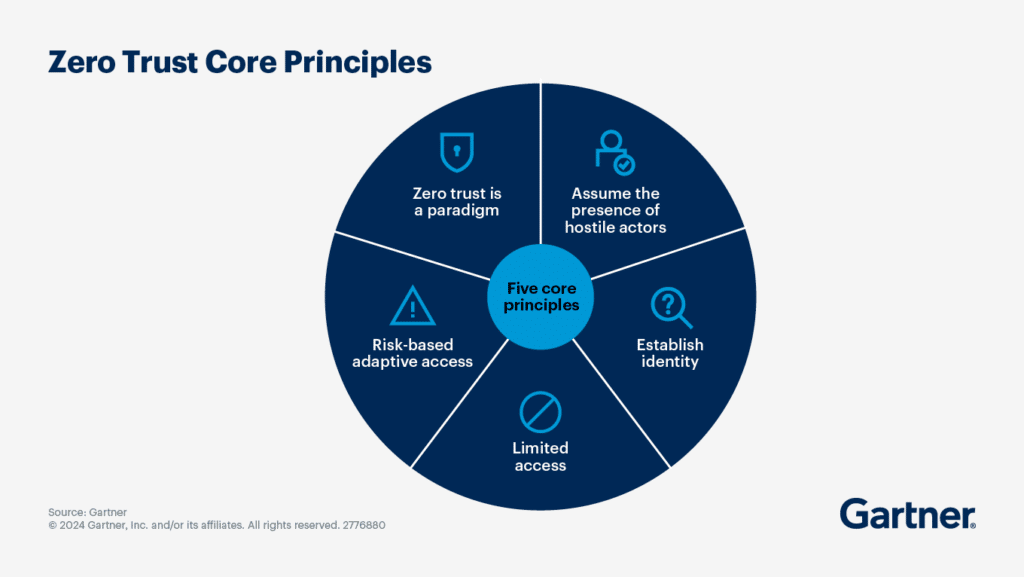Zero Trust has become one of the most talked-about frameworks in cybersecurity, and for good reason. As organizations face increasingly complex threats, many of which originate inside their own networks, the idea of “never trust, always verify” offers a much-needed shift in thinking.
But there’s a catch: too many organizations treat Zero Trust as something they can buy, install, or outsource.

In reality, Zero Trust is less about technology and more about behavior. It’s not a product—it’s a mindset. And if that mindset doesn’t reach every corner of the company, even the best tools won’t make a difference.
Rethinking the Foundation: What Zero Trust Really Means
Zero Trust begins with a simple idea: don’t automatically trust anything. Not a device, not a user, and not even an internal system. Every interaction must be verified continuously based on context, role, and risk.
That might sound strict, but in today’s environment where perimeters are blurred and remote access is widespread, it’s necessary. Older models relied on the assumption that anyone inside the network was trustworthy. That assumption no longer holds up.
The Department of Defense’s Zero Trust Progress Report makes it clear—Zero Trust isn’t just a technical adjustment. It’s a full shift in how organizations think about identity, access, and accountability.
Why People Are the Heart of Zero Trust
Employees Don’t Need to Be Experts—But They Do Need to Understand
Security programs often fail because employees don’t know why changes are being made or what’s expected of them. When security is seen as IT’s responsibility instead of a shared effort, it tends to get ignored or bypassed.
As the Forbes Tech Council notes, the human element is both the biggest risk and the greatest opportunity in Zero Trust. When people are educated, supported, and empowered, they become a critical part of the solution.
This starts with communication. Telling people to “use multi-factor authentication” or “don’t click suspicious links” isn’t enough. They need to understand the risks behind the rule. When employees see the bigger picture, they’re more likely to make smarter decisions.
Culture Changes Behavior More Than Policy
Creating a Zero Trust culture means moving past check-the-box compliance and focusing on behavior. If your team is afraid of making mistakes or sees security as a roadblock, they’ll find ways to work around it.
Organizations that succeed with Zero Trust foster internal trust. They encourage employees to ask questions, challenge assumptions, and report when something feels off.
More importantly, they reward secure behavior. Instead of punishing someone for clicking a malicious link, they treat it as a chance to learn. That kind of culture builds long-term awareness and accountability—something policies alone can’t do.
It’s Everyone’s Responsibility, Not Just IT’s
Zero Trust doesn’t belong solely to the security team. It affects how legal reviews contracts, how HR onboards employees, how finance approves transactions, and how marketing handles customer data. Every function plays a role.
As highlighted in ComputerWeekly’s article, Zero Trust Is Redefining Cybersecurity in 2025, this approach reshapes how organizations define responsibilities. Security becomes part of how the business operates—not just how the network is managed.
When teams work together to define access, understand shared risks, and close visibility gaps, everyone benefits. That’s the kind of collaboration Zero Trust depends on.
Tools Help, But They’re Not the Whole Story
There are plenty of tools that claim to make Zero Trust easier: identity management platforms, endpoint protections, analytics dashboards. But buying tools alone doesn’t solve the problem.
In fact, relying on tech without context can create more confusion. A dashboard full of alerts means little if no one knows what to do with them. And even the best access controls can be sidestepped if users are under pressure and don’t see the value in following protocol.
The starting point for Zero Trust is visibility. Know who has access to what—and why. Understand how data moves across the organization. Once that’s clear, you can make better decisions about where to apply controls and how to reduce risk.
Technology works best when it’s supported by clear expectations, regular training, and a culture that encourages security-minded behavior. If someone feels like they have to ignore security to get their job done, the system is already failing—no matter how advanced the software is.
How to Build a Human-Centered Zero Trust Program
If you want Zero Trust to be more than a theory, start with your people. Here are four steps that can make a real difference:
- Tell Stories That Stick
People connect with stories more than rules. Don’t just roll out new policies—share real incidents. Talk about how small missteps led to big consequences. That kind of storytelling makes security real.
- Challenge Assumptions
Every organization has blind spots. Ask where you might be relying on trust by default. Who has broad access “just in case”? What systems were set up years ago and never reviewed? These are often the riskiest areas.
- Build Smart Habits
Zero Trust isn’t about slowing people down—it’s about helping them think before they act. Whether it’s verifying a request or reviewing access levels, those small habits add up. Make double-checking part of the norm.
- Link Security to Performance
People care about what’s measured. Include secure behavior in performance conversations. Recognize those who report issues or flag risks. When security aligns with success, it becomes part of the culture instead of a barrier to it.
Final Thoughts: Start With Mindset, Then Add the Tools
Zero Trust is more than a framework—it’s a mindset. It forces organizations to question old assumptions and approach trust with more intention.
The most successful companies don’t start with software purchases. They start by building internal alignment. They talk openly about risk, listen to employee feedback, and create a culture where security is everyone’s job.
When that happens, Zero Trust isn’t just a security strategy—it becomes part of how work gets done.